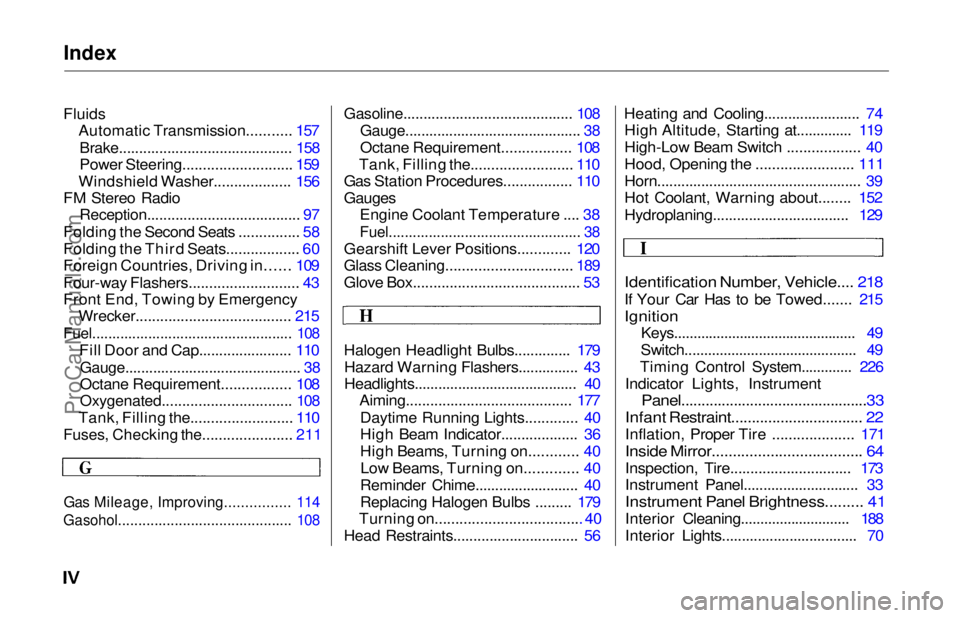Page 124 of 241

Parking
Always use the parking brake when
you park your vehicle. The indicator on the instrument panel shows that
the parking brake is not fully released; it does not indicate that the
parking brake is firmly set. Make sure the parking brake is set firmly
or your vehicle may roll if it is
parked on an incline.
Set the parking brake before you put
the transmission in Park. This keeps
the vehicle from moving and putting
pressure on the parking mechanism
in the transmission — making it easier to move the shift lever out of
Park when you want to drive away. If the vehicle is facing uphill, turn
the front wheels away from the curb.
If the vehicle is facing downhill, turn
the front wheels toward the curb.
Make sure the parking brake is fully
released before driving away.
Driving with the parking brake
partially set can overheat or damage the rear brakes, and will cause the
ABS indicator to light. Parking Tips
Make sure the sunroof and the
windows are closed.
Turn off the lights. Place any packages, valuables, etc.,
in the cargo area or take them
with you.
Lock the doors with the key or the
remote transmitter.
Never park over dry leaves, tall
grass, or other flammable
materials. The three way catalytic
converter gets very hot, and could
cause these materials to catch on
fire.
DrivingProCarManuals.comMain Menu Table of Contents s t
Page 128 of 241

The Braking System, Driving in Bad Weather
If anything goes wrong, the ABS
indicator on the instrument panel
comes on (see page 35). This means
the anti-lock function of the braking
system has shut down. The brakes
still work like a conventional system
without anti-lock, providing normal stopping ability. You should have the
dealer inspect your vehicle as soon
as possible if this light stays on after
you start the engine, or comes on while driving. Driving in Bad Weather
Rain, fog, and snow conditions re-
quire a different driving technique
because of reduced traction and
visibility. Keep your car well- maintained and exercise greater
caution when you need to drive in
bad weather. The cruise controlshould not be used in these condi-
tions. Driving Technique — Always drive
slower than you would in dry
weather. It takes your car longer to react, even in conditions that may
seem just barely damp. Apply
smooth, even pressure to all the
controls. Abrupt steering wheel
movements or sudden, hard appli-
cation of the brakes can cause loss of
control in wet weather. Be extra
cautious for the first few miles (kilometers) of driving while you
adjust to the change in driving
conditions. This is especially true in snow. A person can forget some
snow-driving techniques during the
summer months. Practice is needed
to relearn those skills.
Exercise extra caution when driving
in rain after a long dry spell. After
months of dry weather, the first
rains bring oil to the surface of the
roadway, making it slippery.
DrivingProCarManuals.comMain Menu Table of Contents s t
Page 236 of 241

Index
Fluids Automatic Transmission........... 157
Brake........................................... 158
Power Steering........................... 159
Windshield Washer................... 156
FM Stereo Radio
Reception...................................... 97
Folding the Second Seats ............... 58
Folding the Third Seats.................. 60
Foreign Countries, Driving in...... 109
Four-way Flashers........................... 43
Front End, Towing by Emergency Wrecker...................................... 215
Fuel.................................................. 108
Fill Door and Cap....................... 110
Gauge............................................ 38
Octane Requirement................. 108
Oxygenated................................ 108
Tank, Filling the......................... 110
Fuses, Checking the...................... 211
Gas Mileage, Improving................ 114
Gasohol........................................... 108
Gasoline.......................................... 108
Gauge............................................ 38
Octane Requirement................. 108
Tank, Filling the......................... 110
Gas Station Procedures................. 110
Gauges Engine Coolant Temperature .... 38
Fuel................................................ 38
Gearshift Lever Positions............. 120
Glass Cleaning............................... 189
Glove Box......................................... 53
Halogen Headlight Bulbs.............. 179 Hazard Warning Flashers............... 43
Headlights......................................... 40 Aiming......................................... 177
Daytime Running Lights............. 40
High Beam Indicator................... 36
High Beams, Turning on............ 40Low Beams, Turning on............. 40
Reminder Chime.......................... 40
Replacing Halogen Bulbs ......... 179
Turning on....................................
40
Head Restraints...............................
56Heating and Cooling........................ 74
High Altitude, Starting at.............. 119
High-Low Beam Switch .................. 40
Hood, Opening the ........................ 111
Horn................................................... 39
Hot Coolant, Warning about........ 152
Hydroplaning.................................. 129
Identification Number, Vehicle.... 218
If Your Car Has to be Towed....... 215
Ignition
Keys............................................... 49
Switch............................................ 49
Timing Control System............. 226
Indicator Lights, Instrument
Panel..............................................33
Infant Restraint................................ 22
Inflation, Proper Tire .................... 171
Inside Mirror.................................... 64
Inspection, Tire.............................. 173
Instrument Panel............................. 33
Instrument Panel Brightness......... 41
Interior Cleaning............................ 188
Interior Lights.................................. 70ProCarManuals.comMain Menu s t